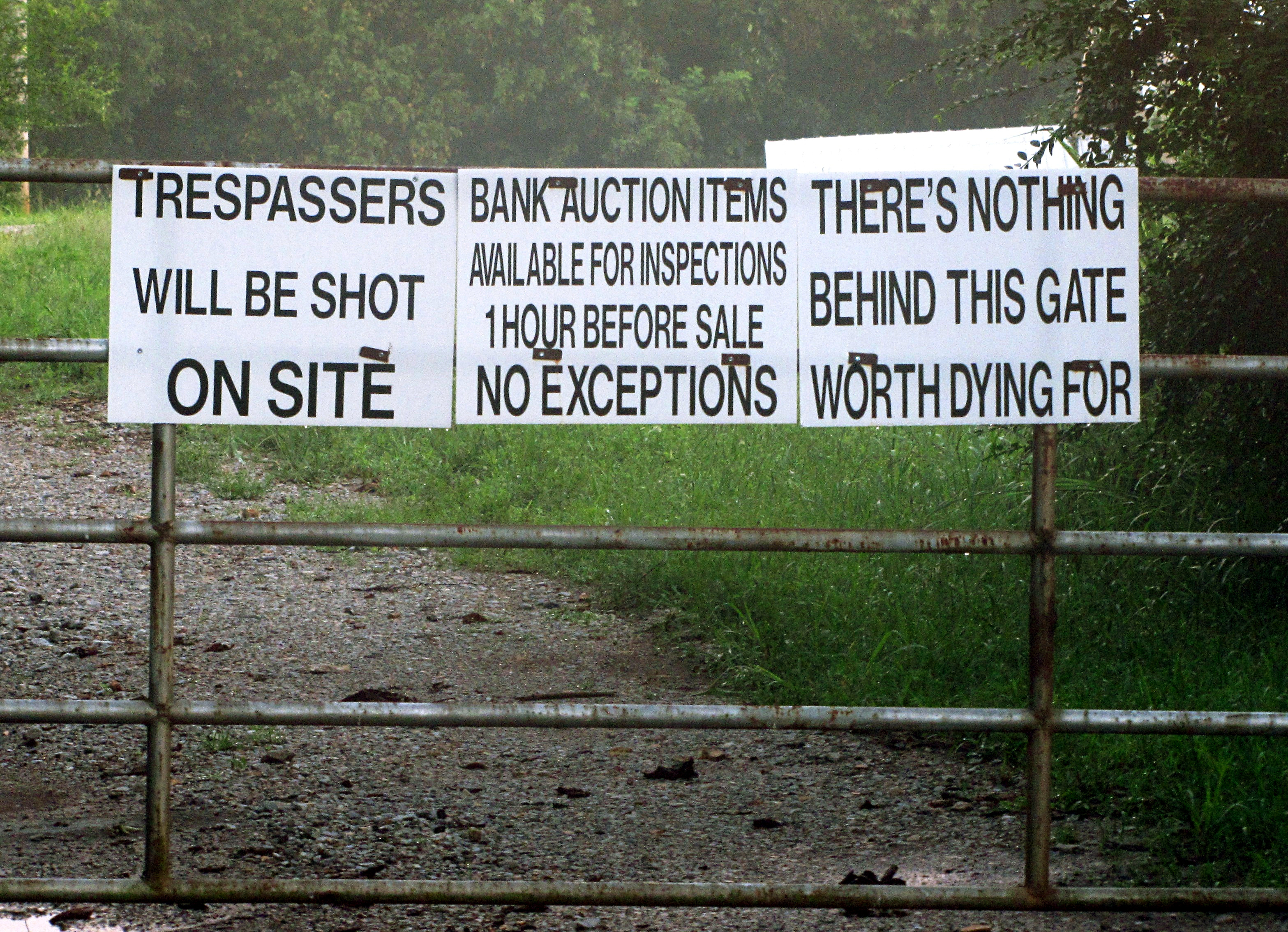|
Trespasser
In the law of tort, property, and criminal law a trespasser is a person who commits the act of trespassing on a property, that is, without the permission of the owner. Being present on land as a trespasser thereto creates liability in the trespasser, so long as the trespass is intentional. At the same time, the status of a visitor as a trespasser (as opposed to an invitee or a licensee) defines the legal rights of the visitor if they are injured due to the negligence of the property owner. Trespassing as a tort The tort of trespass to land requires an intentional physical invasion of the plaintiff's real property by the defendant or a refusal to leave when ordered to leave. Intent required For example, a person walking in a public park who trips and rolls down a hill will not be liable for trespass just because the bottom of the hill is on private land. Physical invasion The trespasser need not enter the land in person. Indeed, if A and B are standing next to C's land, ... [...More Info...] [...Related Items...] OR: [Wikipedia] [Google] [Baidu] |
Licensee
A licensee can mean the holder of a license or, in U.S. tort law, is a person who is on the property of another, despite the fact that the property is not open to the general public, because the owner of the property has allowed the licensee to enter. The status of a visitor as a licensee (as opposed to a trespasser or an invitee) defines the legal rights of the visitor if they are injured due to the negligence of the property possessor (not necessarily the owner). Where licensees are present, activities conducted on the land by or at the behest of the owner of the land must be conducted with the care that a prudent person would show. A duty to warn arises if there is a harmful condition on the land that is hidden from the licensee, so long as the landowner knows of this condition. The licensee falls between the anticipated or discovered trespasser and the invitee on the sliding scale of tort liability assessed to landowners. Whereas the anticipated trespasser needs to be protec ... [...More Info...] [...Related Items...] OR: [Wikipedia] [Google] [Baidu] |
Castle Doctrine
A castle doctrine, also known as a castle law or a defense of habitation law, is a legal doctrine that designates a person's abode or any legally occupied place (for example, an automobile or a home) as a place in which that person has protections and immunities permitting one, in certain circumstances, to use force (up to and including deadly force) to defend oneself against an intruder, free from legal prosecution for the consequences of the force used. The term is most commonly used in the United States, though many other countries invoke comparable principles in their laws. Depending on the location, a person may have a duty to retreat to avoid violence if one can reasonably do so. Castle doctrines lessen the duty to retreat when an individual is assaulted within one's own home. Deadly force may either be justifiable homicide, justified, the Prima facie, burdens of production and Burden of proof (law), proof for charges impeded, or an affirmative defense against criminal homic ... [...More Info...] [...Related Items...] OR: [Wikipedia] [Google] [Baidu] |
Trespassing
Trespass to land, also called trespass to realty or trespass to real property, or sometimes simply trespass, is a common law tort or a crime that is committed when an individual or the object of an individual intentionally (or, in Australia, negligently) enters the land of another without a lawful excuse. Trespass to land is ''actionable per se''. Thus, the party whose land is entered upon may sue even if no actual harm is done. In some jurisdictions, this rule may also apply to entry upon public land having restricted access. A court may order payment of damages or an injunction to remedy the tort. By law, trespass for mesne profits is a suit against someone who has been ejected from property that did not belong to them. The suit is for recovery of damages the trespasser caused to the property and for any profits he or she may have made while in possession of that property. For a trespass to be actionable, the tortfeasor must voluntarily go to a specific location but need ... [...More Info...] [...Related Items...] OR: [Wikipedia] [Google] [Baidu] |
Common Law
Common law (also known as judicial precedent, judge-made law, or case law) is the body of law primarily developed through judicial decisions rather than statutes. Although common law may incorporate certain statutes, it is largely based on precedent—judicial rulings made in previous similar cases. The presiding judge determines which precedents to apply in deciding each new case. Common law is deeply rooted in Precedent, ''stare decisis'' ("to stand by things decided"), where courts follow precedents established by previous decisions. When a similar case has been resolved, courts typically align their reasoning with the precedent set in that decision. However, in a "case of first impression" with no precedent or clear legislative guidance, judges are empowered to resolve the issue and establish new precedent. The common law, so named because it was common to all the king's courts across England, originated in the practices of the courts of the English kings in the centuries fo ... [...More Info...] [...Related Items...] OR: [Wikipedia] [Google] [Baidu] |
Tort
A tort is a civil wrong, other than breach of contract, that causes a claimant to suffer loss or harm, resulting in legal liability for the person who commits the tortious act. Tort law can be contrasted with criminal law, which deals with criminal wrongs that are punishable by the state. While criminal law aims to punish individuals who commit crimes, tort law aims to compensate individuals who suffer harm as a result of the actions of others. Some wrongful acts, such as assault and battery, can result in both a civil lawsuit and a criminal prosecution in countries where the civil and criminal legal systems are separate. Tort law may also be contrasted with contract law, which provides civil remedies after breach of a duty that arises from a contract. Obligations in both tort and criminal law are more fundamental and are imposed regardless of whether the parties have a contract. While tort law in civil law jurisdictions largely derives from Roman law, common law jurisdictio ... [...More Info...] [...Related Items...] OR: [Wikipedia] [Google] [Baidu] |
Duty To Warn
A duty to warn is a concept that arises in the law of torts in a number of circumstances, indicating that a party will be held liable for injuries caused to another, where the party had the opportunity to warn the other of a hazard and failed to do so. History In the United States, two landmark legal cases established therapists' legal obligations to breach confidentiality if they believe a client poses a risk to himself or others. The first was '' Tarasoff v. Regents of the University of California'' (1976), where a therapist failed to inform a young woman and her parents of specific death threats made by a client. The other case was '' Jablonski by Pahls v. United States'' (1983), which further extended the responsibilities of duty to warn by including the review of previous records that might include a history of violent behavior. Product liability The duty to warn arises in product liability cases, as manufacturers can be held liable for injuries caused by their product ... [...More Info...] [...Related Items...] OR: [Wikipedia] [Google] [Baidu] |
Invitee
In the law of torts, an invitee is a person who is invited to land by the possessor of the land as a member of the public or one who enters the land of another for the purpose of business dealings with the possessor of the land. The status of a visitor as an invitee (as opposed to a trespasser or a licensee) defines the legal rights of the visitor if they are injured due to the negligence of the property owner. There are generally two types of invitees:. * Business Invitee is a person who enters business property to do business with the land occupier. * Public Invitee is a person who enters land in the possession of another for the purpose for which the property is held open to the public, even if no business purpose is involved. Even if "invited" onto somebody's premises, a social guest is classified as a licensee. The property owner has a duty to make the property safe for the invitee, which includes conducting a reasonable inspection of the premises to uncover hidden dange ... [...More Info...] [...Related Items...] OR: [Wikipedia] [Google] [Baidu] |
Attractive Nuisance
The attractive nuisance doctrine applies to the law of torts in some jurisdictions. It states that a landowner may be held liable for injuries to children trespassing on the land if the injury is caused by an object on the land that is likely to attract children. The doctrine is designed to protect children who are unable to appreciate the risk posed by the object, by imposing a liability on the landowner. The doctrine has been applied to hold landowners liable for injuries caused by abandoned cars, piles of lumber or sand, trampolines, and swimming pools. However, it can be applied to virtually anything on the property. There is no set cutoff point that defines youth. The courts will evaluate each "child" on a case-by-case basis to see if the "child" qualifies as a youth. If it is determined that the child was able to understand and appreciate the hazard, the doctrine of attractive nuisance will not likely apply. Under the old common law, the plaintiff (either the child, or ... [...More Info...] [...Related Items...] OR: [Wikipedia] [Google] [Baidu] |
Wildlife
Wildlife refers to domestication, undomesticated animals and uncultivated plant species which can exist in their natural habitat, but has come to include all organisms that grow or live wilderness, wild in an area without being species, introduced by humans. Wildlife was also synonymous to game (hunting), game: those birds and mammals that were trophy hunting, hunted for sport. Wildlife can be found in all ecosystems. Deserts, plains, grasslands, woodlands, forests, and other areas including the most developed urban areas, all have distinct forms of wildlife. While the term in popular culture usually refers to animals that are untouched by human factors, most scientists agree that much wildlife is human impact on the environment, affected by human behavior, human activities. Some wildlife threaten human safety, health, property and quality of life. However, many wild animals, even the dangerous ones, have value to human beings. This value might be economic, educational, or emotio ... [...More Info...] [...Related Items...] OR: [Wikipedia] [Google] [Baidu] |
Criminal Law
Criminal law is the body of law that relates to crime. It proscribes conduct perceived as threatening, harmful, or otherwise endangering to the property, health, safety, and Well-being, welfare of people inclusive of one's self. Most criminal law is established by statute, which is to say that the laws are enacted by a legislature. Criminal law includes the punishment and Rehabilitation (penology), rehabilitation of people who violate such laws. Criminal law varies according to jurisdiction, and differs from Civil law (common law), civil law, where emphasis is more on dispute resolution and victim compensation, rather than on punishment or Rehabilitation (penology), rehabilitation. Criminal procedure is a formalized official activity that authenticates the fact of commission of a crime and authorizes punitive or rehabilitative treatment of the Criminal, offender. History The first Civilization, civilizations generally did not distinguish between Civil law (area), civil law and ... [...More Info...] [...Related Items...] OR: [Wikipedia] [Google] [Baidu] |
Duty To Retreat
In law, the duty to retreat, or requirement of safe retreat,''Criminal Law - Cases and Materials'', 7th ed. 2012, Wolters Kluwer Law & Business; John Kaplan, Robert Weisberg, Guyora Binder, /ref> is a legal requirement in some jurisdictions that a threatened person cannot harm another in self-defense (especially lethal force) when it is possible instead to retreat to a place of safety. This requirement contrasts with some other jurisdictions to '' stand one's ground'', meaning being allowed to defend one's self instead of retreating. It is a specific component which sometimes appears in the criminal defense of self-defense, and which must be addressed if criminal defendants are to prove that their conduct was justified. Depending on the state the criminal defendants have to prove a minimal time period of safe retreat. English law In English law English law is the common law list of national legal systems, legal system of England and Wales, comprising mainly English cr ... [...More Info...] [...Related Items...] OR: [Wikipedia] [Google] [Baidu] |





